South African medics make big effort to save Hope the rhino
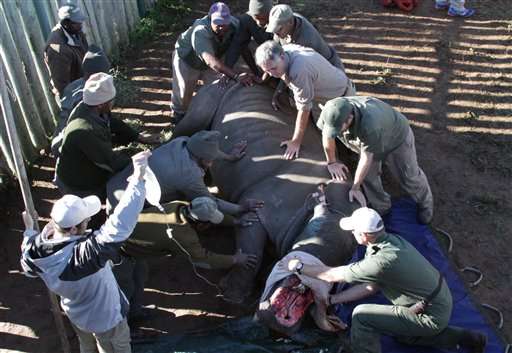
The horns and a large portion of the rhino's face were severed by poachers, a horrific injury that had some observers wincing at the sight of exposed flesh and bone. One South African veterinarian treating the mutilated survivor was so distressed at the rhino's suffering that he stepped away briefly, his eyes glassy with tears.
Then Dr. Johan Marais, an equine and wildlife surgeon at the University of Pretoria, rejoined the extraordinary effort to save the life of one rhino named Hope, as a small group of veterinarians learns on the job about a species increasingly being slaughtered or maimed by poachers.
"You just can't believe that somebody from our own species can do that to an animal," Marais said later. Awful to behold, the gaping wound of the 4-year-old female rhino is reminiscent of an anatomical diagram in a textbook that shows the cross-section of a skull or body. The rhino's eyes barely escaped injury.
On Monday, vets cleaned and dressed the injury before securing a fiberglass shield on what remained of the rhino's face with wire stitches and steel screws drilled into the skull. An Associated Press team and several other journalists witnessed the operation on the sedated, 1.8-ton animal in a muddy enclosure on the edge of Shamwari Game Reserve, near the South African city of Port Elizabeth.
Hope's caregivers seek to rally support for what could ultimately be a positive story of survival amid the escalating poaching in South Africa, which harbors about 20,000 rhinos, roughly 90 percent of the world's population.
The South African government recorded more than 1,200 poached rhinos last year, reflecting growing demand in parts of Asia where rhino horn is believed to have medical benefits. There is no scientific evidence that it does; the horn is made of keratin, a protein also found in human fingernails.
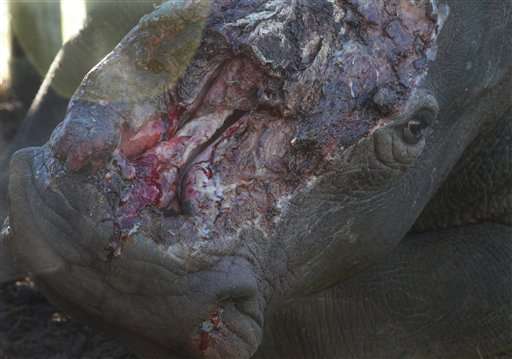
The rhino being attended to on Monday was darted by poachers who hacked off her horns while she was sedated, fracturing her nasal bone and exposing the sinus cavities and nasal passage. The attack happened in Lombardini, a wildlife park where poachers recently killed several other rhinos. Discovered alive days later, the rhino was named Hope by rescuers. She was moved to the nearby Shamwari reserve, where an initial surgery occurred on May 18.
She is "a voice for what the species is going through," said Dr. William Fowlds, a wildlife veterinarian who was the anesthesiologist on Monday. The delicate task required monitoring of the rhino's temperature and blood pressure and an awareness that the slumbering rhino could be a danger if it were to awaken and stumble around the enclosure.
At interludes, Fowlds injected drugs that partly revived the rhino, which groggily got to its feet as park staff swarmed around, steadying its immense bulk. A rhino can suffer potentially fatal muscle damage if it lies or sits too long in one position because its tremendous weight reduces blood flow.
Fowlds, Marais and another vet, Dr. Gerhard Steenkamp, belong to Saving the Survivors, a group that treats rhinos with gunshot wounds, facial gouges and other poaching injuries. The group has treated 10 injured rhinos in the last few years; nine survived. Hope's wound, measuring 50 by 28 centimeters (19.6 by 11 inches), is among the worst that the doctors have seen.
They said there is little medical research on rhinos. They are mapping bone structure and learning what painkillers, antibiotics and other drugs to use as they go along. Hope's treatment is expected to cost tens of thousands of dollars and last about a year and a half. She faces an estimated two dozen medical procedures, including periodic replacement of the facial shield, before the wound is fully healed.
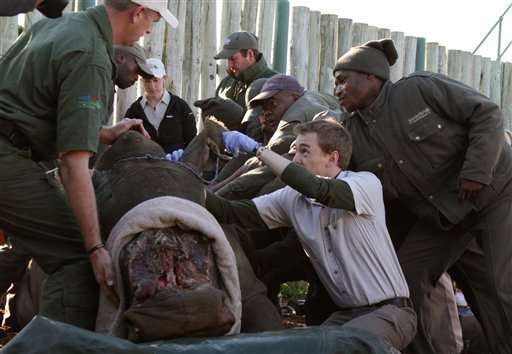
Suzanne Boswell Rudham, a Saving the Survivors spokeswoman, said individual donations from overseas were increasing as Hope's story spreads. But the South African response was lackluster, she added, citing possible "rhino fatigue" among people numbed by dire reports about African poaching, which sometimes include allegations of state corruption.
Police in neighboring Mozambique arrested 11 people, including police officers, who are suspected of stealing 12 rhino horns, the Mozambique News Agency reported Monday. The horns belonged to a massive seizure of 340 elephant tusks and 65 rhino horns in a raid in Mozambique in which two Chinese were arrested, the agency said. South Africa is assessing whether the horns came from rhinos poached from its own parks.
Poachers who dart rhinos, a take-down method that is stealthier than firearms and less likely to draw rangers' attention, have used a tranquilizer that only veterinarians can legally buy and use, Fowlds said. He said that reflected corruption "either in the pharmaceutical side or through the veterinary supply chain."
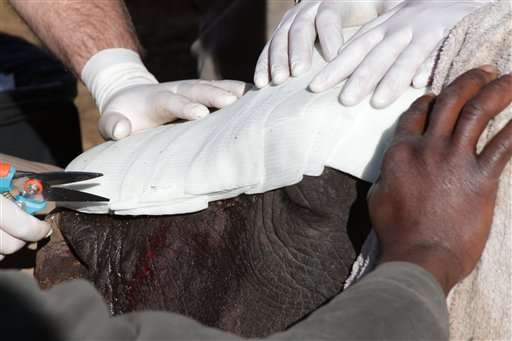
Thandi, a South African rhino whose horns were hacked off in 2012, recovered and gave birth in January after treatment. The hope is that the rhino named Hope will do the same.
"This is going to be a marathon," Steenkamp said of Hope's treatment. "We are being pushed by these poachers to push our boundaries."
-
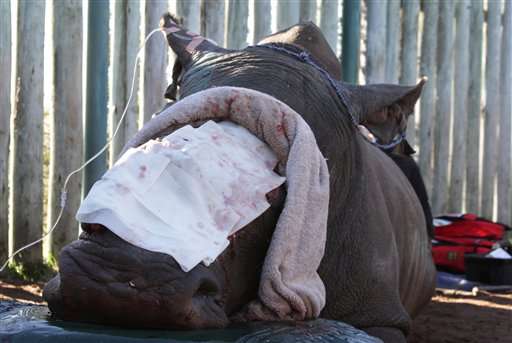
Hope, a rhino survivor, undergoes surgery Monday, June 8, 2015 at Shamwari Game Reserve near Port Elizabeth, South Africa. Hope was darted by poachers recently at a nearby reserve and had her horns hacked off while she was sedated, fracturing her nasal bone and exposing the sinus cavities and nasal passages. (AP Photo/Courtney Quirin) -
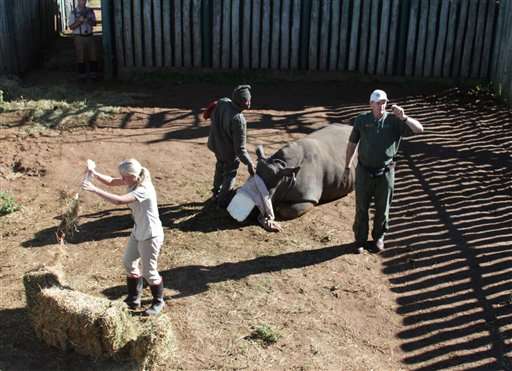
Hope, a rhino survivor, is settled in her pen after surgery Monday, June 8, 2015 at Shamwari Game Reserve near Port Elizabeth, South Africa. Hope was darted by poachers recently at a nearby reserve and had her horns hacked off while she was sedated, fracturing her nasal bone and exposing the sinus cavities and nasal passages. (AP Photo/Courtney Quirin)
© 2015 The Associated Press. All rights reserved.




















